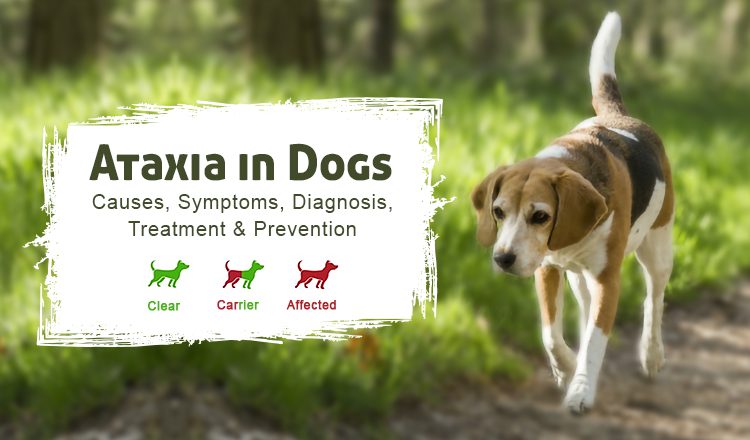
Ataxia in dogs: symptoms and treatment
Ataxia is a condition that affects the nervous system and causes incoordination in dogs. Although such a deviation may not seem too serious, it is one of the most important clinical signs of the disease and indicates that the animal needs veterinary care. It is necessary to find out the root cause of this condition as soon as possible and provide the pet with the necessary treatment.
What are the types of ataxia and how to recognize their signs?
Contents
Ataxia in dogs: symptoms and signs
Causes of ataxia in dogs can range from toxin poisoning and drug side effects to nutritional deficiencies, metabolic disease, birth defects, or spinal cord disease.
Ataxia may appear suddenly or develop gradually and chronically, depending on its underlying cause. In addition, the degree of the disease can vary from mild to severe. Signs of ataxia in dogs depend on the cause, but generally include the following:
- weakness;
- frequent tripping or staggering;
- uncoordinated gait;
- wide stance paws;
- difficulty getting up;
- walking in circles;
- tilting the body or walking with a slope to one side;
- lethargy;
- head tilt to the side;
- abnormal eye movements, particularly from side to side or up and down;
- abnormal position of the eyes;
- lack of appetite;
- vomiting;
- changes in mental state.
If your dog exhibits some of these signs, you need to pay close attention to his posture and gait.
Types of ataxia in dogs
Most types of disease can be divided into three main categories:
- Vestibular ataxia in dogs. This type of violation is usually the easiest to recognize. Vestibular ataxia may present with head tilt, markedly abnormal eye movements, and a gait that resembles walking in a circle rather than a straight line. In addition, signs such as body tilt, rolling and falling are often observed. A common, but not the only, cause of vestibular ataxia is idiopathic vestibular syndrome, or vestibular disease in older dogs.
- Cerebellar ataxia in dogs. This form of dysfunction may present as unusual physical signs. In cerebellar ataxia, the dog cannot control the speed and range of its gait. Often it looks as if the pet deliberately raises its paws higher – as if it were climbing stairs. Cerebellar ataxia is caused by damage to the cerebellum of the brain.
- Proprioceptive ataxia in dogs. This disorder is primarily associated with damage to the spinal cord. In this condition, the dog is less likely to show signs in the head area, such as tremors, head tilt, or abnormal eye movements. The physical signs seen in proprioceptive ataxia are usually associated with the trunk and limbs and include, among others, unsteadiness, weakness of the limbs, and inability to straighten them normally. An example of a disease that has such a clinical picture is spinal cord compression.
Diagnosis of ataxia in dogs
The very word “ataxia” describes the physical manifestation of a violation of muscle coherence. With it, the dog cannot properly coordinate the movements of the head, trunk and paws. This is not the same as muscle weakness that affects muscle strength, also called paresis, or lameness or limping. They, in turn, are associated with a violation of the function of a particular part of the body. However, ataxia only affects the dog’s ability to coordinate body movements.
To begin sorting out the long list of causes of ataxia in dogs, the attending veterinarian will take a detailed history and perform a neurological examination along with a routine physical examination. A neurological examination will allow the specialist to determine the type of ataxia. After that, he will be able to recommend the necessary diagnostic studies.
Prevention and treatment of ataxia in dogs
While there is no universal way to prevent ataxia, keeping your dog healthy can help prevent specific causes. For example, earinfection, which develop in the inner ear and cause inflammation and associated vestibular ataxia.
Treatment of ataxia in dogs is also non-specific. First of all, it is necessary to accurately determine and characterize the type of disease. It is extremely important for the veterinarian to correctly locate the physical focus that caused the development of the disease. Treatment ranges from small changes in daily routine to surgery to remove or reduce the lesion. Hospitalization early in diagnosis may be helpful for fluid management and medication to help control clinical signs of ataxia in dogs, such as vomiting.
Continued veterinary supervision ensures that any orthopedic or debilitating conditions are properly ruled out and not left untreated.
In most cases, the dog is helped by home care, which should be provided until he can walk normally. Animals with ataxia may need assistance with walking and feeding by hand during the period when the lack of coordination is most pronounced. In some cases, the dog will have to be helped to go to the toilet.
In general, if you provide a four-legged friend with maximum comfort while he is recovering, then he will return to his usual cheerful state in the shortest possible time.
See also:
- Cancer in Dogs: Causes, Diagnosis and Treatment
- Brain Aging in Dogs: Symptoms and Treatment
- Cough in a dog – we understand the reasons
- Shortness of breath in dogs: when to sound the alarm





